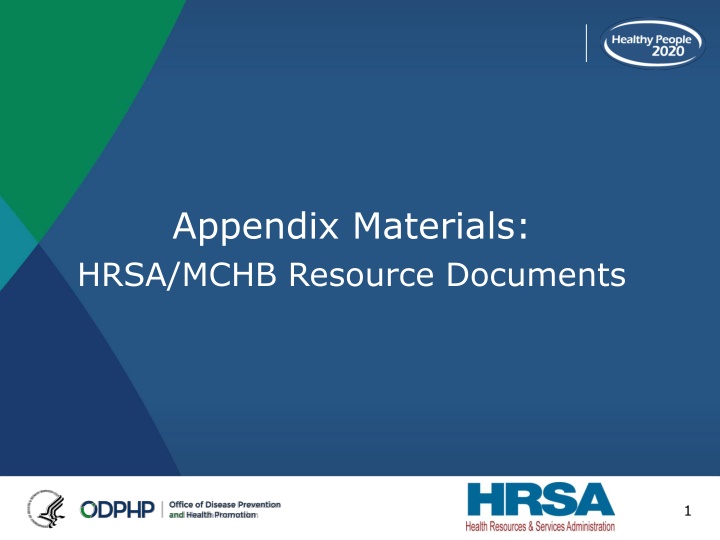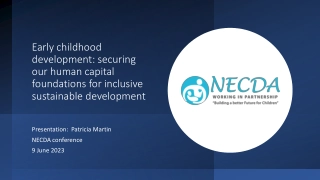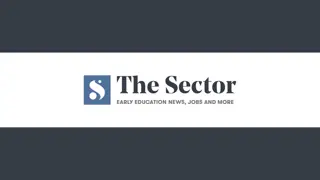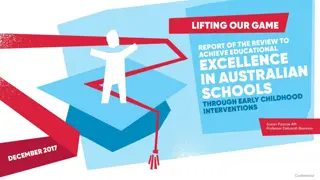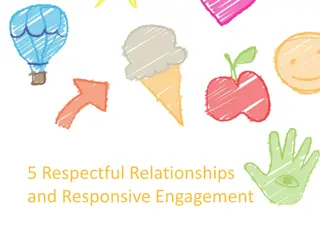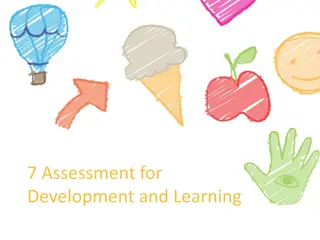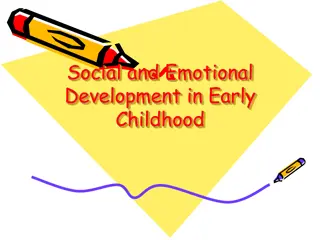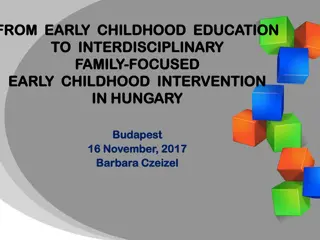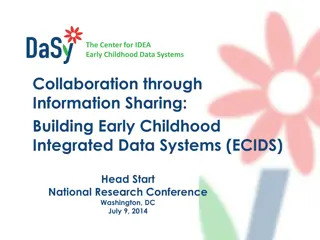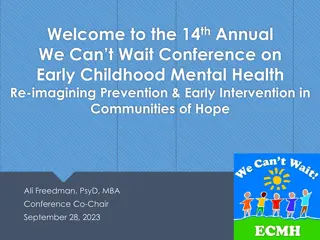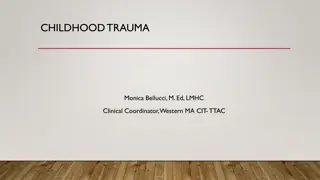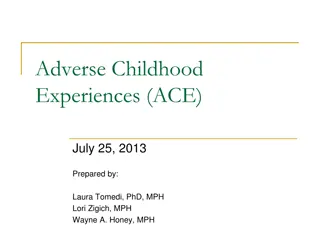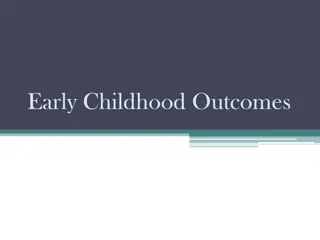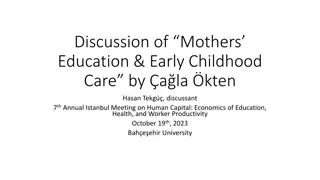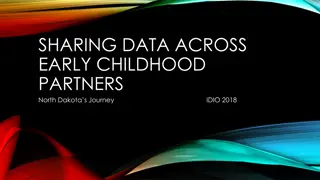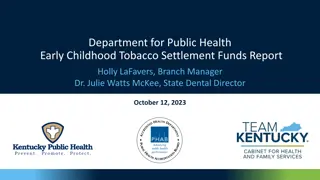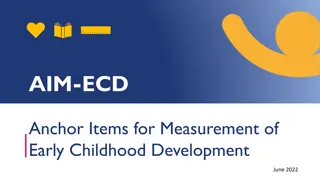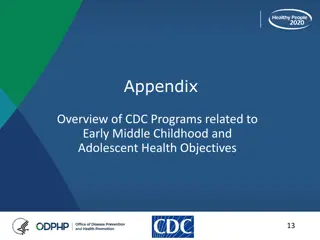Early Childhood Healthy Development Strategies
In this collection of resources, explore objectives aligned with HRSA/MCHB grant programs for early and middle childhood health. Discover performance measures, impact grantees, and valuable resources for promoting healthy development in young children.
Download Presentation

Please find below an Image/Link to download the presentation.
The content on the website is provided AS IS for your information and personal use only. It may not be sold, licensed, or shared on other websites without obtaining consent from the author.If you encounter any issues during the download, it is possible that the publisher has removed the file from their server.
You are allowed to download the files provided on this website for personal or commercial use, subject to the condition that they are used lawfully. All files are the property of their respective owners.
The content on the website is provided AS IS for your information and personal use only. It may not be sold, licensed, or shared on other websites without obtaining consent from the author.
E N D
Presentation Transcript
Appendix Materials: HRSA/MCHB Resource Documents 1
Early and Middle Childhood Healthy People 2020 Objective Statements Aligned with HRSA/MCHB Grant Programs EMC-1(Developmental): Increase the proportion of children who are ready for school in all five domains of healthy development: Physical development, social-emotional development, approaches to learning, language, and cognitive development EMC-2: Increase the proportion of parents who use positive parenting and communicate with their doctors or other health care professionals about positive parenting o EMC-2.2: Increase the proportion of parents who use positive communication with their child o EMC-2.3: Increase the proportion of parents who read to their young child 2
MIECHV Program Performance Measures Benchmark Areas Measures 1) Maternal & Newborn Health Preterm Birth; Breastfeeding; Depression Screening, Well-Child Visit; Postpartum Care; Tobacco Cessation Referrals 2) Child Injuries, Maltreatment, & Reduction of Emergency Department Visits Safe Sleep; Child Injury; Child Maltreatment 3) School Readiness & Achievement Parent-Child Interaction; Early Language & Literacy Activities; Developmental Screening; Behavioral Concerns 4) Crime or Domestic Violence Screening for Interpersonal Violence (IPV) 5) Family Economic Self-Sufficiency Primary Caregiver Education; Continuity of Insurance Coverage 6) Coordination & Referrals Completed Depression Referrals; Completed Developmental Referrals; IPV Referrals 3
States with ECCS Impact Grantees Alaska Delaware Florida Hawaii Indiana Kansas Louisiana Massachusetts New Jersey New York Oklahoma Utah 4
HRSA/MCHB Resources for Early Childhood Grant Programs Home Visiting https://mchb.hrsa.gov/maternal-child-health-initiatives/home-visiting-overview Program Brief: https://mchb.hrsa.gov/sites/default/files/mchb/MaternalChildHealthInitiati ves/HomeVisiting/pdf/programbrief.pdf Report to Congress (2016): https://mchb.hrsa.gov/sites/default/files/mchb/MaternalChildHealthInitiati ves/HomeVisiting/pdf/reportcongress-homevisiting.pdf Early Childhood Comprehensive Systems https://mchb.hrsa.gov/earlychildhoodcomprehensivesystems 5
Adolescent Health Healthy People 2020 Objective Statements Aligned with HRSA/MCHB Grant Programs AH-1: Increase the proportion of adolescents who have had a wellness checkup in the past 12 months AH-3.1: Increase the proportion of adolescents who have an adult in their lives with whom they can talk about serious problems AH-5: Increase educational achievement of adolescents & young adults o AH-5.1: Increase the proportion of students who graduate with a regular diploma 4 years after starting 9th grade o AH-5.2: Increase the proportion of students served under the Individuals with Disabilities Education Act who graduate high school with a diploma o AH-5.5: Increase the proportion of adolescents who consider their schoolwork to be meaningful and important o AH-5.6: Decrease school absenteeism among adolescents due to illness or injury 6
Adolescent Health Healthy People 2020 Objective Statements Aligned with HRSA/MCHB Grant Programs (cont) AH-7: Reduce the proportion of adolescents who have been offered, sold, or given an illegal drug on school property AH-8: Increase the proportion of adolescents whose parents consider them to be safe at school AH-9: Increase the proportion of middle & high schools that prohibit harassment based on a student s sexual orientation or gender identity AH-10: Reduce the proportion of public schools with a serious violent incident AH-11: Reduce adolescent & young adult perpetration of, & victimization by, crimes o AH-11.1: Reduce the rate of minor & young adult perpetration of violent crimes o AH-11.2: Reduce the rate of minor & young adult perpetration of serious property crimes o AH-11.3: Decrease the proportion of secondary school students who report the presence of youth gangs at school during the school year o AH-11.4: Reduce the rate of adolescent & young adult victimization from crimes of violence 7
States Participating in the Adolescent Wellness Checkup CoIIN* Indiana Iowa Maryland Minnesota Mississippi New Hampshire New Jersey New Mexico Texas Vermont Washington Wyoming *There have been two cohorts of states. 8
States Represented by Participants in CoIINs for SBHCs and CSMHSs States SBHCs CSMHSs Notes SBHC school-based health center California Colorado Connecticut Illinois Kansas Maryland Massachusetts Minnesota New Hampshire New York North Carolina Ohio Rhode Island Tennessee Washington Washington, D.C. Wisconsin CSMHS comprehensive school mental health system SBHC CoIIN Teams of multiple SBHCs from 7 states have participated in CoIIN activities. A total of 72 SBHC sites have participated in the 13 CoIIN teams. CSMHS CoIIN Most CoIIN participants have been school districts, and a total of 25 school districts across 14 states, collectively containing more than 400 schools, have participated in CoIIN activities. There have been 2 CoIIN cohorts, each lasting 16 months. 9
Resources Describing Adolescent and Young Adult Health & School-Based Health Services Grant Programs Sponsored by HRSA/MCHB Collaborative Improvement and Innovation Networks https://mchb.hrsa.gov/maternal-child-health-initiatives/collaborative-improvement- innovation-networks-coiins Adolescent and Young Adult Health National Resource Center http://nahic.ucsf.edu/resource-center/ CoIIN on School-Based Health Services School-Based Health Centers http://www.sbh4all.org/current_initiatives/nqi/ Community Preventive Services Task Force Recommendation https://www.thecommunityguide.org/findings/promoting-health-equity- through-education-programs-and-policies-school-based-health-centers Comprehensive School Mental Health Systems http://csmh.umaryland.edu/Current-Initiatives/Collaborative-Improvement- and-Innovation-Networks-for-School-Based-Health-Services-CoIIN-SBHS/ https://theshapesystem.com/ 10
